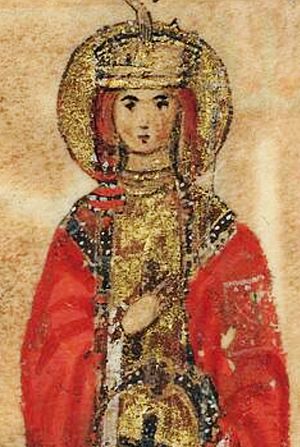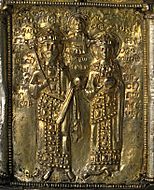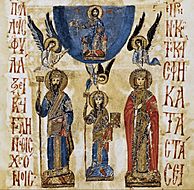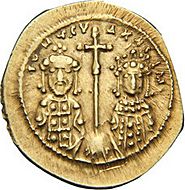Eudokia Makrembolitissa facts for kids
Quick facts for kids Eudokia Makrembolitissa |
|
|---|---|
| Augusta Empress and Autocratess of the Romans |
|

A drawing of Empress Eudokia from her time.
|
|
| Byzantine empress regnant (disputed) | |
| Reign | 22/23 May – 31 December 1067 |
| Predecessor | Constantine X Doukas |
| Successor | Romanos IV Diogenes |
| Co-emperors | Michael VII Doukas Konstantios Doukas |
| Byzantine regent | |
| Regency | late September – late October 1071 |
| Monarch | Michael VII Doukas |
| Byzantine empress consort | |
| Tenure | 1059–1067, 1068–1071 |
| Born | c. 1030 |
| Died | after 1081 |
| Spouse |
|
| Issue more... |
Michael VII Doukas Andronikos Doukas Theodora Doukaina Konstantios Doukas Nikephoros Diogenes Leo Diogenes |
| Dynasty | Makrembolites |
| Father | John Makrembolites |
| Religion | Greek Orthodox |
Eudokia Makrembolitissa (in Greek: Εὐδοκία Μακρεμβολίτισσα) was a powerful Byzantine empress. She was married to two different emperors, Constantine X Doukas and Romanos IV Diogenes.
After her first husband died in 1067, she ruled the empire alongside her sons. To protect the empire, she married Romanos IV. When Romanos was captured in battle in 1071, she briefly took charge again with her son Michael VII. However, she was soon forced to step down and become a nun. Because she ruled with so much authority, many historians today see her as a true ruling empress.
Contents
Early Life and Family
Eudokia Makrembolitissa was born around the year 1030. Her father was John Makrembolites, and her uncle was Michael I Cerularius, a very important religious leader known as the patriarch of Constantinople. Her family was part of the city's nobility.
Around 1049, Eudokia married Constantine X Doukas. She was his second wife. By the time Constantine became emperor in 1059, they already had five children. Eudokia was crowned augusta, the title for an empress, shortly after her husband became emperor.
A Powerful Empress
When Emperor Constantine X became very sick in 1066, he made plans for who would rule after him. He died on May 23, 1067. After his death, Eudokia became the supreme ruler of the Byzantine Empire.
Her son, Michael VII, was old enough to rule, but he let his mother manage the government. The historian Michael Psellos, who lived at the time, wrote that Eudokia took control of the entire administration herself.
Ruling in Her Own Right
Evidence from the time shows that Eudokia was seen as a true ruler. Coins were made that showed her as an equal to her husband, Emperor Constantine X. Some coins and official documents even called her "emperor," a title usually only for men. This suggests she was not just a regent (a person who rules for a child) but a co-ruler with real power.
On some coins, Eudokia is shown in the center between her two sons. This was a special placement that showed she was the senior, or most important, ruler.
Marriage to Romanos IV Diogenes
On his deathbed, Constantine had made Eudokia promise not to marry again. However, Eudokia knew she needed a strong military leader to help her protect the empire from its enemies, especially the Seljuk Turks.
She chose a popular general named Romanos IV Diogenes. To marry him, she had to get permission from the patriarch, John VIII Xiphilinos, who had witnessed her promise. Eudokia cleverly convinced the patriarch to release her from her oath. They were married on January 1, 1068, and Romanos was crowned emperor.
With her new husband, Eudokia had two more sons, Nikephoros and Leo. Romanos also made one of her other sons, Andronikos, a co-emperor. Even so, Eudokia remained very powerful. Some coins from this time called Romanos a despotes (lord) but saved the title basileus (emperor) for Eudokia.
However, Romanos soon began to act on his own and ignore her. This created tension between them and within the government.
Losing the Throne
In 1071, Emperor Romanos IV fought the Seljuk army at the famous Battle of Manzikert. The Byzantine army was defeated, and Romanos was captured.
When the news reached Constantinople, the government declared Romanos was no longer emperor. Eudokia and her son Michael VII were named the new joint rulers. But this new government did not last long. Powerful officials, led by John Doukas, turned against her. They proclaimed Michael VII as the sole emperor and forced Eudokia to leave the palace. She had to retire to a monastery and become a nun.
Later Life
Even from the monastery, Eudokia was still influential. She tried to help her husband Romanos IV get back his throne, but he died in 1072. Eudokia arranged a grand funeral for him.
In 1078, a new emperor, Nikephoros III Botaneiates, came to power. He respected Eudokia and invited her back to Constantinople, even offering to marry her. The marriage never happened, but he sent her many gifts.
The exact date of Eudokia's death is not known, but she lived past the year 1081. One of her last known acts was adopting a relative of the patriarch.
A dictionary of history and mythology was once thought to be written by Eudokia. However, experts now believe it was a fake created in the 16th century by a man named Constantine Paleocappa.
-
A drawing of Constantine X and Eudokia with their son, co-emperor Michael VII Doukas.
-
A gold coin showing Romanos IV Diogenes and Eudokia.
Issue
With her first husband, Constantine X, Eudokia had seven children:
- Michael VII Doukas, who became senior emperor in 1071.
- A son who died as a baby.
- Anne Doukaina, who became a nun.
- Andronikos Doukas, who was a co-emperor.
- Theodora Doukaina, who married the leader of Venice.
- Konstantios Doukas, who was a co-emperor.
- Zoe Doukaina, who married a brother of Emperor Alexios I Komnenos.
With her second husband, Romanos IV, she had two sons:
- Nikephoros Diogenes
- Leo Diogenes
See also
 In Spanish: Eudoxia Macrembolita para niños
In Spanish: Eudoxia Macrembolita para niños





